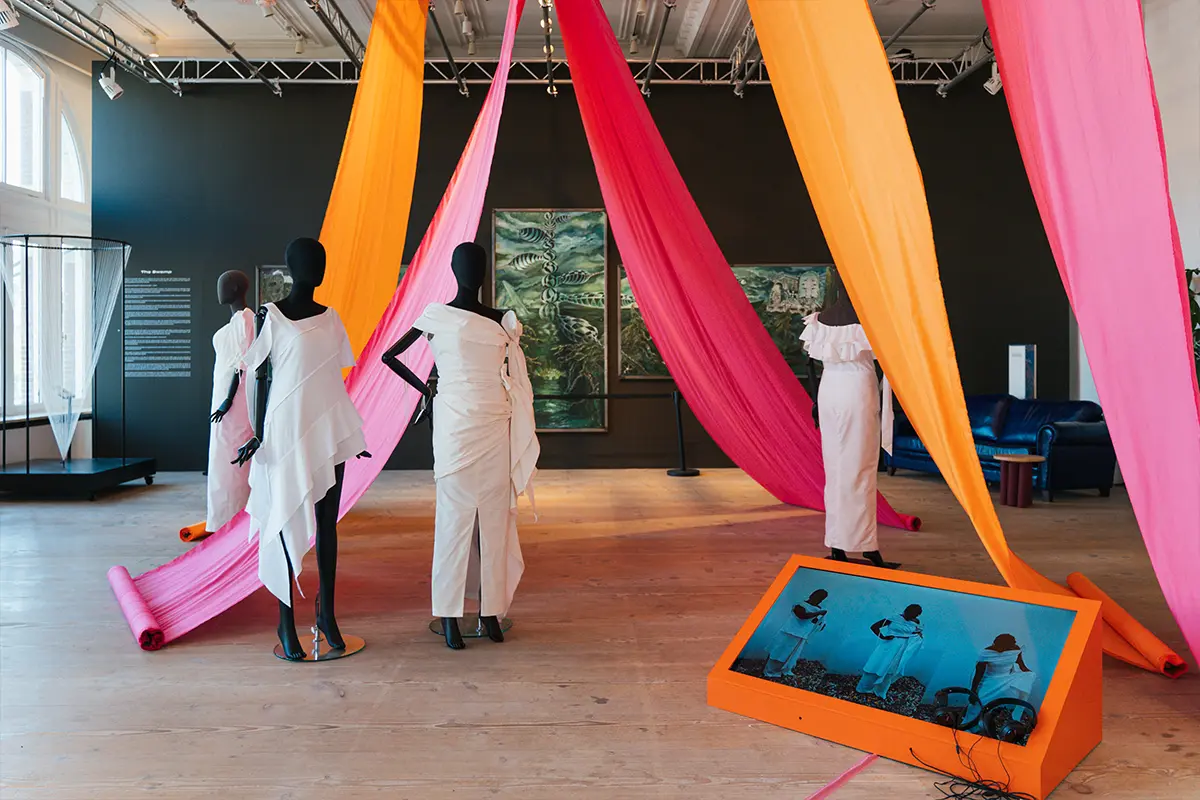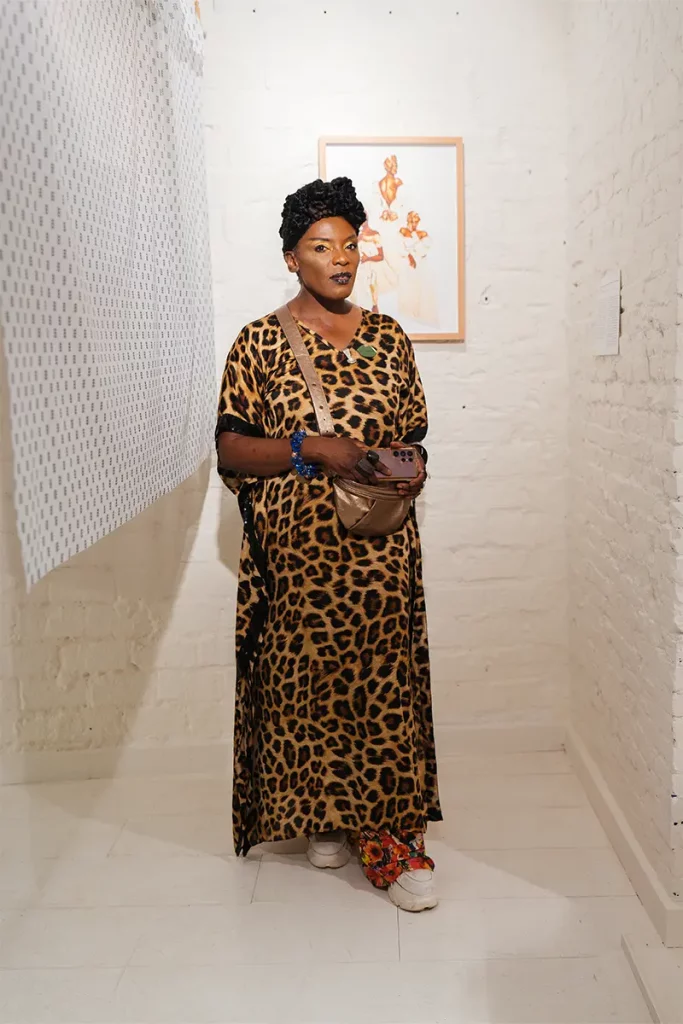The world’s first sustainable fashion museum in Amsterdam invites consumers to expand their view on cotton beyond jeans and T-shirt with the exhibition Flipping the Script
Flipping the Script: rethink obvious cotton classics
Flipping the Script was established at the intersection of fashion, art, and social change. The closing chapter of the exhibition Knowing Cotton Otherwise in Amsterdam invites us to rethink the obviousness of certain ‘conscious’ modern fashion concepts, such as quiet luxury and minimalism, through a wider, global lens.
The latest exhibition includes two new installations from designer Angelo Carlo Marcus Elizabeth and trend researcher Nsimba Valene Lontanga.
‘Conscious choices’ ignore non-Western perspectives
Creative director of the full series, Janice Deul, explains the purpose of chapter three as a revision of the cotton story. Cotton garments that fall under ‘quiet luxury’ and ‘minimalism’ are generally accepted as ‘conscious choices’, but they ignore non-Western perspectives.
For example, African cultures are strongly connected to the material, both as producers and wearers. That is why the exhibition invites visitors to reconsider what timeless classics might look like from a different angle.
Deul: «What is basic? Is that just a T-shirt or could it also be a white wrap dress? Because for people in Africa, that’s basic. We’ve declared things like the classic denim jeans (100 percent cotton) the perfect staple, but we could also take a look at how different people are perceiving this».
Angelo Carlo Marcus Elizabeth’s Guardian’s Garden
The first floor of the museum is dedicated to the Guardian’s Garden, an experience by Angelo Carlo Marcus Elizabeth. Before moving to the mainland, the designer grew up on Caribbean Island Curaçao, spending most of his time in his grandmother’s garden. It was only in 2010, upon the dissolution of the Dutch Antilles, that the former Dutch colony obtained its own government and legislation.
Elizabeth moved to Amsterdam to study fashion design at Academy Artemis. 1863, the original name of the installation currently on display, was his graduation project. It refers to the year in which Dutch slavery was officially abolished – a key moment in history 150 years back in time.
Elizabeth’s installation is a multi-sensorial experience inspired by all that surrounded him in his native region. Guided by the sounds and smells of his Caribbean heritage, the visitor passes several cotton cloths on the backdrop of a flower garden.
After Houndstooth and Breton Stripe comes the Guardian motive
The centerpiece is a mannequin dressed in a voluminous blouse with a newly developed Guardian motive, inspired by both tulips and the hibiscus. With this pattern Elizabeth wants to preserve the cultural histories of his ancestors. Deul explains his goal as questioning classic prints: «We all know the Houndstooth and Breton Stripe, but he has created his own ancestor motif and, in his view, this one has everything it needs to become the next classic».
Homage to resistance heroine Virginia Dementricia
Elizabeth opted for an open back design to commemorate the resilience of his foremothers. The woman he honors with this specific project is resistance heroine Aruban Virginia Dementricia. Born an enslaved in 1842, she soon joined the ‘rebels’ by walking around in public in the fancy clothes of her ‘owner’. As punishment she was physically abused, but that didn’t stop her from continuing.
An African approach to wardrobe staples – Elements of Poetry
The main exhibition floor opened to the work of Nsimba Valene Lontanga Elements of Poetry. With her unexpected ‘capsule collection’ – a selection of white cotton dresses in expressive silhouettes – she pays tribute to the wide range of African fashion styles.
Like Elizabeth, the designer and researcher became intrigued by her history. She refers to those faraway family members as her ‘Aunties’, a designation for older women from African cultures. A Congolese herself, Lontanga wants to remind her audience of the versatile clothing styles these ladies adapted.
Knowing Cotton Otherwise: traditions in African textile production: representative and local
African textile production serves as a representation of its rich cultural heritage. For example, traditional dyeing methods emerge as a prominent industry in the continent. Techniques are generally based on locally available natural resources. Dyers from Yoruba, Hausa and Soninke all use different techniques based on their local environment to create organic indigo’s.
Lontanga’s intention is to acquaint the public with these crafts that were passed on to her, focusing mainly on the traditions of drapery and modular design. Elements of Poetry contains a wrap dress that can be turned into a top, or a baby carrier. The designer also used Zoba Zoba, a patchwork technique that uses upcycled cotton clippings.
‘The African style’ doesn’t exist – Knowing Cotton Otherwise
African fashion is often simplified by persistent Eurocentric perspectives. But there are strong local differences, Deul explains. «The African style – if it exists at all – is usually described as a mixture of prints, colors, and exuberant lines. This installation shows that it is just as much about form and uniprints». Within most African cultures, these ‘expressive’ styles classify as basics or classics.
Wrap techniques make a durable fashion style
Besides nuancing the notions around ‘typical African fashions’, the installation taps into the durable production implications of these styles. Deul: «The most sustainable are the wrap techniques people have been using from time immemorial, so that anyone can wear the garment in a thousand different ways».
Western worldview leads to sustainability misconceptions
The Western fashion industry solutions to combat climate change and pollution are generally found in modern innovations, rather than established practices from foreign cultures. This leads to misconceptions, Deul explains: «In Western countries, we sometimes believe that we ought to export sustainable concepts to those countries, but they are the ones that are ahead of us, in many ways».
This worldview leads to consumers pursuing ‘capsule wardrobes’ defined in a specific, Eurocentric way. From an inclusive perspective, this is not the right approach, Deul says, since many stories about cotton classics in the world remain lesser known. By juxtaposing various historical and future oriented perspectives, the consumer gets the complete picture. This should drive circular transformation within the cotton industry in a way that is also fair towards previous generations.
Traceable organic cotton with fabric fingerprint technology
All garments in Elements of Poetry are made from traceable organic cotton by Ghanaian tailor Tetteh Kwashi. American Cotton manufacturer Supima donated their extra-long staple cotton fibers for the project.
Oritain took care of the traceability of the fabrics using forensic science. They generate fingerprints for cotton fabrics based on their geochemical composition. By checking whether the characteristics of a sample match those of the claimed place of origin, they can verify supposed organic materials at any stage.
Cotton and the fashion system
Cotton is one of the most used raw materials for apparel and fashion. A reasonable estimation of its market share lies between a quarter and one third of total textile fibers production worldwide. Cotton makes a useful fabric for garments due to its softness, strength, and breathability.
On the other hand, the production of cotton is linked to colonialism, slavery, and the climate crisis. Its history left traces that are still visible in modern cotton production.
Recounting cotton stories in Amsterdam makes sense
Fashion for Good’s PR Coordinator Paola Darce believes the introduction of new perspectives on cotton in the Dutch capital makes sense: «Amsterdam is the denim capital of the world, but it also has a rich commercial history in buying and selling as a port, which is deeply intertwined with the legacy of cotton, textile, and slavery around the world. It seems appropriate to create an exhibition here that acknowledges that history».
Amsterdam was also home to the Dutch East India Company (EIC), the first multinational company in the world, she reminds. The EIC made the Dutch wealthy and powerful, and the old structures they built are still permeated in the way cotton and fashion are produced today.
Knowing Cotton Otherwise in Amsterdam
The new exhibition is the final chapter of a tripartite series Knowing Cotton Otherwise that started October 2022. On display are cotton designs from local artists representing different continents. The aim is to encourage the audience to reflect on the role of cotton in their personal lives and to let in new narratives, especially those relating to black diaspora.
Part one recounted the brief history of cotton as an increasingly intertwined web of global cultures that is closely related to fashion. The second phase Bodies of Work zoomed in on the body as a carrier of the widespread cotton story – from the many hands that have worked the material to the skins that touch the finished pieces.
Knowing Cotton Otherwise – Installations represent ancestral, solution-oriented stories
Most installations exhibited in the show Knowing Cotton Otherwise in Amsterdam, highlight forgotten ancestral cotton stories, taking a cultural-historical point of view. At the same time, the series is solution-oriented. With an eye on the polluting side of the cotton industry and its consequences for the planet, multiple modern innovative techniques for efficient, clean cotton production are presented.




















